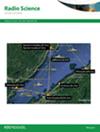基于 Poeverlein 图的解决 Spitze 效应的改进型 3D 数值光线跟踪方法
IF 1.6
4区 地球科学
Q3 ASTRONOMY & ASTROPHYSICS
引用次数: 0
摘要
Spitze 现象与地球磁场密切相关,是电离层中传播的高频(HF)射线的特征。具体来说,当满足反射条件时,高频射线会垂直于地球磁场反射。研究从 Spitze 区域反射的高频射线对于间接了解电离层的磁特性非常重要。三维数值射线追踪法是一种广泛使用的高频射线反演技术。然而,传统的三维 Haselegrove 数值射线追踪方法无法将 Spitze 区域的普通射线追踪回地面。因此,我们根据 Poeverlein 图改进了传统的射线追踪方法。改进后的方法可以改变普通光线在非常接近 Spitze 反射点时的传播方向。这样,就可以消除 Spitze 造成的普通光线传播中断。为了验证这一改进,我们提供了一个示例,展示了在安静电离层下用传统和改进的光线追踪方法追踪到的普通光线和非常规光线。此外,还设计了大尺度、中尺度和小尺度 TID 的三种扰动电离层背景来模拟各种高频射线,以进一步验证。模拟结果表明,静电离层和扰动电离层中都存在 Spitze,改进后的光线跟踪方法可以正确解决普通光线跟踪中的 Spitze 效应。本文章由计算机程序翻译,如有差异,请以英文原文为准。
An improved 3D numerical ray-tracing method for solving the spitze effects based on poeverlein's diagram
The Spitze phenomenon is closely related to the Earth's magnetic field, and characterizes high-frequency (HF) rays propagating in the ionosphere. Specifically, when the reflection conditions are satisfied, HF rays are reflected perpendicular to the Earth's magnetic field. Studying the HF rays reflected from the Spitze region is important to indirectly learn about the ionosphere magnetic properties. The 3D numerical ray-tracing method is a widely used HF rays inversion technique. However, the conventional 3D Haselegrove numerical ray-tracing method can not trace the ordinary rays in the Spitze region back to the ground. Therefore, we improved the conventional ray-tracing method based on Poeverlein's diagram. The improved method can change the ordinary rays' propagation directions when they travel very close to the Spitze reflection point. In this way, the ordinary rays' propagation interruption caused by the Spitze can be eliminated. An example showing the ordinary and extraordinary rays traced by the conventional and improved ray-tracing methods under the quiet ionosphere is provided to validate the improvement. In addition, three disturbed ionospheric backgrounds with large-scale, medium-scale, and small-scale TIDs are designed to simulate various HF rays for further validation. The simulation results show that the Spitze exists in the quiet and disturbed ionosphere, and the improved ray-tracing method can properly solve the Spitze effects on the traced ordinary rays.
求助全文
通过发布文献求助,成功后即可免费获取论文全文。
去求助
来源期刊

Radio Science
工程技术-地球化学与地球物理
CiteScore
3.30
自引率
12.50%
发文量
112
审稿时长
1 months
期刊介绍:
Radio Science (RDS) publishes original scientific contributions on radio-frequency electromagnetic-propagation and its applications. Contributions covering measurement, modelling, prediction and forecasting techniques pertinent to fields and waves - including antennas, signals and systems, the terrestrial and space environment and radio propagation problems in radio astronomy - are welcome. Contributions may address propagation through, interaction with, and remote sensing of structures, geophysical media, plasmas, and materials, as well as the application of radio frequency electromagnetic techniques to remote sensing of the Earth and other bodies in the solar system.
 求助内容:
求助内容: 应助结果提醒方式:
应助结果提醒方式:


